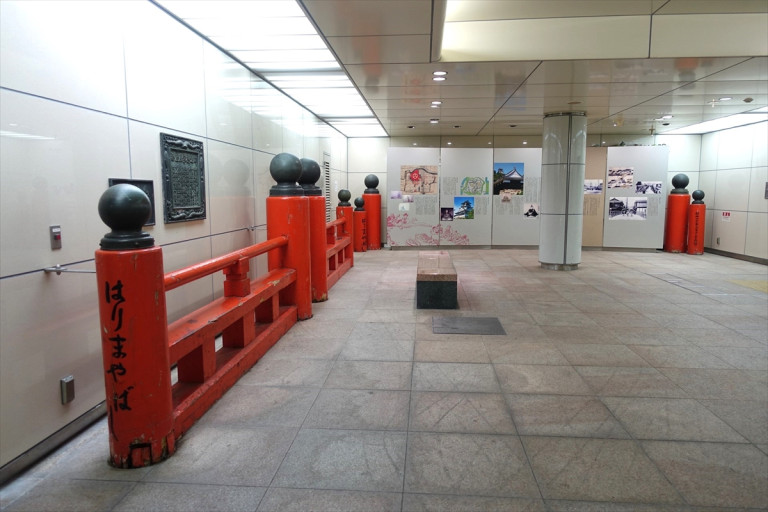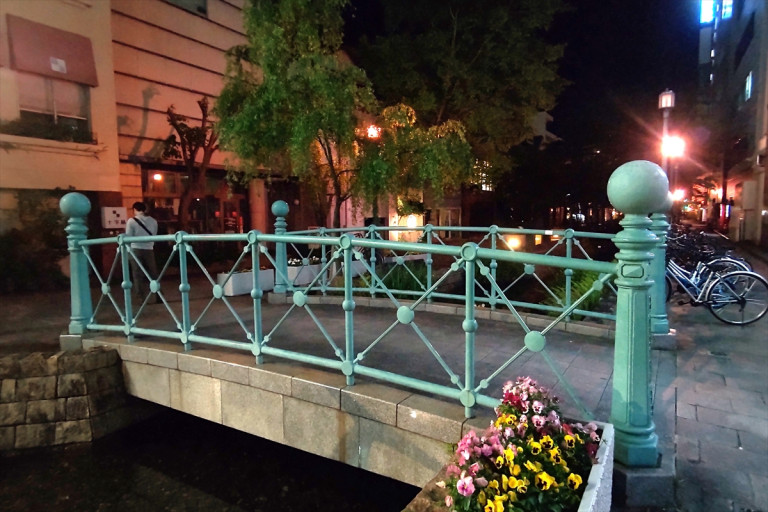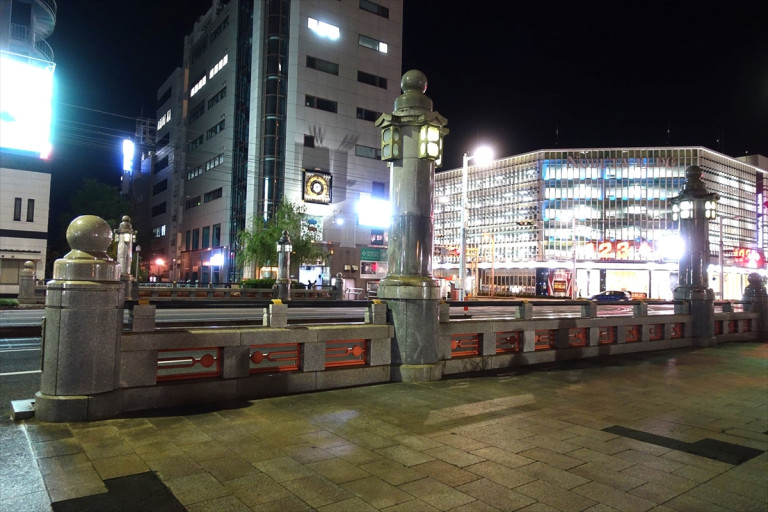
In fact, this tourist attraction is four things–and a whole lot of history–in one!
Did you know that Japan has three famous places that are considered the most disappointing sightseeing spots in the country? One of them is Harimaya Bridge in Kochi City, Kochi Prefecture, on the island of Shikoku. Our Japanese-language reporter Haruka Takagi went to check it out, just to see what all the anti-fuss was about. What she actually found was quite interesting…interesting enough that she thinks the title is unwarranted.
Throughout Kochi City, Haruka saw the names “Harimaya” (はりやま) and “Harimaya Bridge” (はりやま橋) everywhere. In convenience store branch names…
▼ Family Mart’s Kochi Minami Harimaya-cho Branch
In a new apartment building name…
▼ Leben Harimaya Bridge Mid Court
Even in the name of a no-frills business hotel!
▼ Business Hotel Verde Harimaya Bridge
Signs of “Harimaya Bridge” (“Harimaya-bashi” in Japanese) were scattered all over the city. There’s no way it couldn’t pique Haruka’s interest. With such prominent naming, how could the word on the street be that it was one of Japan’s top three most disappointing sightseeing spots?
Having previously visited the Sapporo Clock Tower, another of the top three, Haruka expected Harimaya Bridge to be small and boring. She made sure to temper her expectations before visiting it.
To her surprise, when she visited after sundown, the area around the bridge was actually full of activity. There were plenty of shops and restaurants nearby, and tourists who’d imbibed a bit of alcohol were already trundling in crowds down the street.
The bridge itself is made of wood and painted vermillion, and quite a bit more refined than Haruka expected. It felt a little incongruous with the rowdy atmosphere, but Haruka thought it might be a good representation a sort of “neo-Japan” aesthetic.
Harimaya Bridge was originally built in the Edo period to connect two shops on opposite sides of the Horikawa River, Harimaya and Hitotsuya. The new-looking version was rebuilt in March 1998 as a replica of the earlier Harimaya Bridge.
Although it’s very new compared to the original bridge from hundreds of years ago, the current iteration is still over 20 years old. It looks shiny and bright from afar, but up close, the paint on the railings has chipped and the wooden surface underneath is peeking through.
Probably the most disappointing thing about it is that the river underneath the bridge is less a river and more of a river-shaped pond. But still…Haruka had to say that it really wasn’t so disappointing that it should be ranked in the Japan Top 3.
And that was the end of her tour! Or so she’d thought, but then she stumbled upon several unexpected things. First, when Haruka headed west from the bridge…
She found a mysterious set of stairs leading underground. At the bottom was an underground walkway that headed east under National Route 32.
And when she got all the way to the end…
She found a whole other Harimaya Bridge!
The balustrades had “Harimaya Bridge” painted on them, and the pieces looked much older than the one over the river-pond.
It turned out that this bridge was originally built in 1958, and was later replaced in 1997. On its retirement, it was brought down here and put on display. But no since the Harimaya Bridge was originally built in the Edo period, this too was an entirely different bridge altogether.
An old photo decorating the underground exhibit area showed the bridge on display acting as a barrier between the road and the sidewalk. It did appear to be a crossing for both pedestrians and cars, however, so it must have been much bigger than the current display implies.
The black-and-white photo next to it was what caught Haruka’s eye next. It depicted three kimono-clad women crossing a bridge that looked totally unlike the other two bridges Haruka had seen.
It turns out that this bridge was also called Harimaya Bridge. Clearly, the Harimaya Bridges have played many different roles over time. Perhaps we should consider Harimaya Bridge not a landmark but a name to be inherited.
When Haruka finished browsing the display, she climbed back up to the surface, where, to her surprise, she found the same bridge in the photo crossing over a pond.
It was made of cast iron and painted a teal color. Apparently, this bridge was originally built in December 1908, and though it looks like it’s been repainted in recent years, it definitely has the rough texture of bridges built in this style.
It didn’t always sit on that spot either. At the beginning of the Showa Era in the 1920s, the bridge was relocated to the garden of Sansuien, a ryokan (traditional inn) in Kochi City, where it stayed for a long time. It moved to its current location in 1998.
Haruka couldn’t help but be impressed by the beauty of this historical item. She thought it should be something in a museum, preserved inside a glass case, and yet it was there on a popular pathway for anyone to walk over. That gave it a lot of value, in her opinion.
As she watched a man cross over the bridge at a rapid, determined pace, Haruka feel moved. Clearly, despite being a relic of history, the bridge has been completely reintegrated into the community. What’s more, the bright city lights of the shopping area reflected in the pond gave the area a mysterious air, like time was mixed up here.
There was still one more Harimaya Bridge, and this one came as a surprise to Haruka because she’d already seen it multiple times while out walking in the town. It was a stone railing that separated the sidewalk from National Route 32.
When Haruka investigated, she learned that, like the others, it was also decorated with the words “Harimaya Bridge.”
When the second Harimaya Bridge, the one on display in the underground exhibit, was removed in 1998, this Harimaya Bridge was built in its place.
Since the canal has long been filled in, it’s less of a bridge than it is just a roadway decoration. In terms of Instagrammability, the first, second, and third Harimaya Bridges might have a little more impact, but this one was still pretty cool since it has clearly evolved over the decades to keep up with the times.
So that makes four different Harimaya bridges! Let’s break them down by era to make it easier to differentiate them.
The Edo-era (1603-1868) Harimaya Bridge was made of wood. It no longer exists.
The Harimaya Bridge built in the Meiji era (1908) was the one made of cast iron, and it currently resides east of National Route 32. This was the third bridge that Haruka found on her walk.
The Harimaya Bridge on display in the underground exhibition era was built in the Showa era (1954). It has vermillion balustrades and is made of concrete, and once was a large pedestrian path situated alongside a roadway (this was the second Harimaya Bridge that Haruka found).
In the Heisei period (1998), the red balustrades of this bridge were removed and replaced with the stone balustrades currently separating the sidewalk from National Route 32 (this was the fourth bridge that Haruka found).
And lastly, around the same time (1997), this replica of the Edo-era Harimaya Bridge was built in a popular tourist area (this was the first bridge that Haruka encountered).
The fact that there are four different bridges with the same name in four different places in the same neighborhood that seem to connect the dots of history was actually really fascinating. Who in the world decided that this sightseeing spot was disappointing?
In the underground walkway, there’s even a tile reproduction of an Edo-era scroll that houses a painting of Kochi City from the time decorating the wall.
And when you look closely at the artwork…
You can find the Edo-era Harimaya Bridge! What Haruka had heard was true; the original bridge connected two shopping areas separated by a river.
Over the years the Harimaya Bridges have undoubtedly accomplished many things and witnessed many more. They’ve been built, rebuilt, relocated, and returned, now serving as both community connectors and sightseeing spots.
With four different spots to explore, all packed with history, Haruka would say that there’s nothing disappointing about the Harimaya Bridges, and if you find yourself in Kochi City, they’re definitely worth checking out. And perhaps you’ll also encounter the mighty Shinjo-kun while you’re in the area!
Images © SoraNews24
● Want to hear about SoraNews24’s latest articles as soon as they’re published? Follow us on Facebook and Twitter!
[ Read in Japanese ]




























 Japan’s new luxury sightseeing train will show you part of the country most foreigners never see
Japan’s new luxury sightseeing train will show you part of the country most foreigners never see Japan’s Three Most Disappointing Tourist Sites: Sapporo Clock Tower
Japan’s Three Most Disappointing Tourist Sites: Sapporo Clock Tower Century-old Hiroshima brewery in one of Japan’s three great sake-brewing spots offers tours in English
Century-old Hiroshima brewery in one of Japan’s three great sake-brewing spots offers tours in English Disillusionment at Tsukiji’s tourist-target prices led us to a great ramen restaurant in Tokyo
Disillusionment at Tsukiji’s tourist-target prices led us to a great ramen restaurant in Tokyo Lacquerware supplier to emperor of Japan and Pokémon team up for new tableware
Lacquerware supplier to emperor of Japan and Pokémon team up for new tableware Dove ad slams Japanese beauty ideals, backfires with complaints from public instead
Dove ad slams Japanese beauty ideals, backfires with complaints from public instead Starbucks on a Shinkansen bullet train platform: 6 tips for using the automated store in Japan
Starbucks on a Shinkansen bullet train platform: 6 tips for using the automated store in Japan Skip Tsukiji sushi?!? This seafood-stock ramen restaurant is a great reason to do just that
Skip Tsukiji sushi?!? This seafood-stock ramen restaurant is a great reason to do just that Nintendo’s controller capsule toys are so cool, even the machine you buy them from is awesome【Pics】
Nintendo’s controller capsule toys are so cool, even the machine you buy them from is awesome【Pics】 Tokyo police stopped us for random questioning, so we asked them to recommend a good restaurant
Tokyo police stopped us for random questioning, so we asked them to recommend a good restaurant Pokémon Christmas season starting early with adorable new line of fashions and decorations【Pics】
Pokémon Christmas season starting early with adorable new line of fashions and decorations【Pics】 7-Eleven Japan now sells…matcha burritos?!?
7-Eleven Japan now sells…matcha burritos?!? Japan’s Grimoire Bag lets you carry your stuff like a magical boss
Japan’s Grimoire Bag lets you carry your stuff like a magical boss 7-Eleven Japan starts new temporary luggage storage service in over 300 branches
7-Eleven Japan starts new temporary luggage storage service in over 300 branches Starbucks teams up with 166-year-old Kyoto doll maker for Year of the Horse decorations【Photos】
Starbucks teams up with 166-year-old Kyoto doll maker for Year of the Horse decorations【Photos】 Tokyo’s Tsukiji sushi neighborhood asks tour groups to stay away for the rest of the month
Tokyo’s Tsukiji sushi neighborhood asks tour groups to stay away for the rest of the month Street Fighter Hadouken Churros to be launched and eaten in Tokyo, Okami pudding on offer too
Street Fighter Hadouken Churros to be launched and eaten in Tokyo, Okami pudding on offer too Japanese woman mistaken for bear
Japanese woman mistaken for bear Return of Totoro sequel short anime announced for Ghibli Park
Return of Totoro sequel short anime announced for Ghibli Park Starbucks Japan releases new zodiac chilled cup drink for 2026
Starbucks Japan releases new zodiac chilled cup drink for 2026 Is this the most relaxing Starbucks in Japan?
Is this the most relaxing Starbucks in Japan? Japan’s human washing machines will go on sale to general public, demos to be held in Tokyo
Japan’s human washing machines will go on sale to general public, demos to be held in Tokyo Japanese train company is letting fans buy its actual ticket gates for their homes
Japanese train company is letting fans buy its actual ticket gates for their homes Is China’s don’t-go-to-Japan warning affecting tourist crowds in Tokyo’s Asakusa neighborhood?
Is China’s don’t-go-to-Japan warning affecting tourist crowds in Tokyo’s Asakusa neighborhood? Starbucks Japan unveils new Christmas goods and a rhinestone tumbler that costs 19,500 yen
Starbucks Japan unveils new Christmas goods and a rhinestone tumbler that costs 19,500 yen Tokyo considering law requiring more trash cans following litter increase in heavily touristed area
Tokyo considering law requiring more trash cans following litter increase in heavily touristed area Nintendo’s Kirby now delivering orders at Kura Sushi restaurants, but not in Japan
Nintendo’s Kirby now delivering orders at Kura Sushi restaurants, but not in Japan Tokyo event lets you travel back in time, for free, to celebrate 100 years since Showa era start
Tokyo event lets you travel back in time, for free, to celebrate 100 years since Showa era start Survey asks foreign tourists what bothered them in Japan, more than half gave same answer
Survey asks foreign tourists what bothered them in Japan, more than half gave same answer Japan’s deadliest food claims more victims, but why do people keep eating it for New Year’s?
Japan’s deadliest food claims more victims, but why do people keep eating it for New Year’s? We deeply regret going into this tunnel on our walk in the mountains of Japan
We deeply regret going into this tunnel on our walk in the mountains of Japan Studio Ghibli releases Kodama forest spirits from Princess Mononoke to light up your home
Studio Ghibli releases Kodama forest spirits from Princess Mononoke to light up your home Major Japanese hotel chain says reservations via overseas booking sites may not be valid
Major Japanese hotel chain says reservations via overseas booking sites may not be valid Put sesame oil in your coffee? Japanese maker says it’s the best way to start your day【Taste test】
Put sesame oil in your coffee? Japanese maker says it’s the best way to start your day【Taste test】 The top 10 annoying foreign tourist behaviors on trains, as chosen by Japanese people【Survey】
The top 10 annoying foreign tourist behaviors on trains, as chosen by Japanese people【Survey】 No more using real katana for tourism activities, Japan’s National Police Agency says
No more using real katana for tourism activities, Japan’s National Police Agency says Starbucks Japan reveals new sakura drinkware collection, inspired by evening cherry blossoms
Starbucks Japan reveals new sakura drinkware collection, inspired by evening cherry blossoms
Leave a Reply